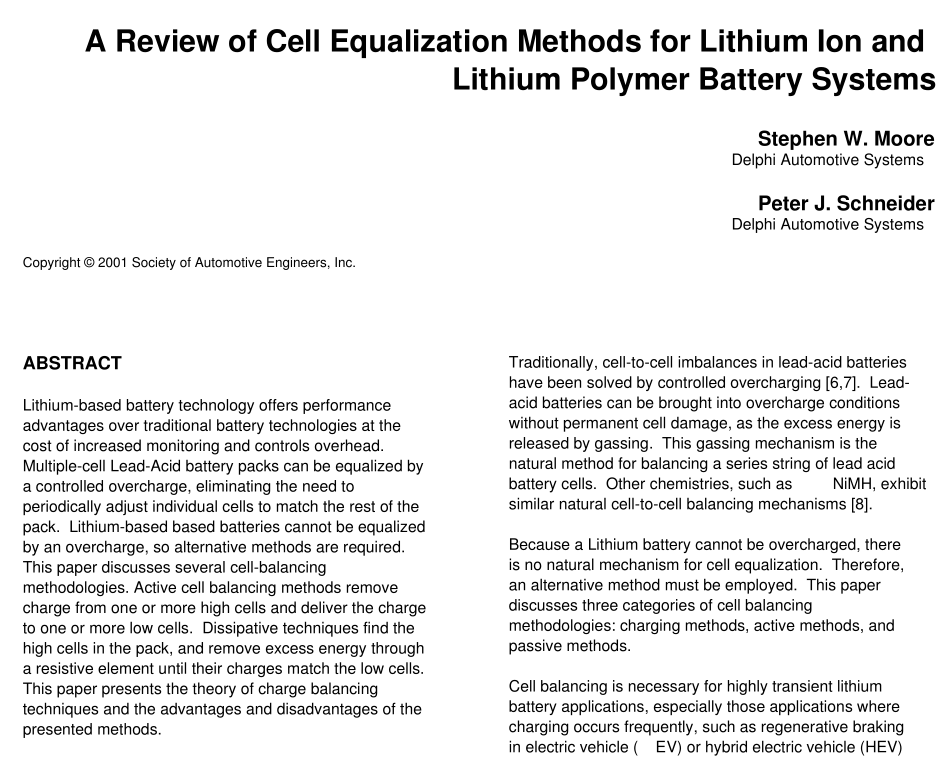SAE 0959:2001 pdf download A Review of Cell Equalization Methods for Lithium Ion and Lithium Polymer Battery Systems
For EV applications, a 1 0mA/Ahr resistor could specify a 1 A resistor current for a 1 00Ahr battery pack, meaning a 4W resistor per lithium cell (4V/cell). Such large values could result in a costly design with thermal management requirements. CONCLUSIONS Electric vehicle applications can benefit from cell- balancing devices, especially for lithium-based battery chemistries. Since battery pack charging is limited by any one single cell reaching its end-of-charge voltage (4.1 V to 4.3 V), it is useful to control high voltage cells until the lower voltage cells catch up. This way, each cell can be charged to its end-of-charge voltage. Several cell-balancing methods are suitable for EV applications. Charge shunting methods work well but are limited by the amount of current that must be dissipated.
The shared transformer method is applicable, but it is costly in terms of magnetics and parts count. The dissipative method is applicable, and is the most cost effective. Charge shuttling methods would be prohibitively expensive due to the switches required to handle the large peak capacitor charging currents. Hybrid electric vehicle applications typically feature regenerative braking, battery charging and electric motoring. These features put high demands on the battery pack for both charging and discharging.
The battery pack is usually not kept in a fully charged condition; rather it is marginally charged, leaving room at the top for charge acceptance. Thus, charge shunting is not an applicable solution. Since some HEV designs features battery packs significantly smaller than their EV counterparts, charge shuttling methods become more attractive with smaller peak switch currents. However, the amount of energy dissipated in capacitor ESR and switching losses may not justify the increased complexity and expense. The dissipative method is effective without the complexity and expense. However, the algorithm development is significantly more involved. REFERENCES
[1 ] N. Furukawa et all, “EV 24h Travel Distance Record Challenge,” the 1 7 th International Electric Vehicle Symposium (EVS-1 7), Montreal, Canada, 2000
[2] Ph. Blanchard, D. Cesbron, G. Rigobert and G. Sarre, “PERFORMANCE OF SAFT LI-ION BATTERIES FOR ELECTRIC VEHICLES,” the 1 7 th International Electric Vehicle Symposium (EVS-1 7), Montreal, Canada, 2000
[3] M. Okada, H. Yasuda, M. Yamachi, E. Yagasaki, and S. Hashizume, “Porous Polymer Electrolyte Li Ion Battery with Superior Performance,” Electric Vehicle Symposium 1 6 (EVS1 6), 1 999
[4] Segawa, M., S. Hitomi, H. Yasuda, M. Yamachi, “Effects of Porous Polymer Electrolyte on Electrochemical Characteristics for LiNi1 -xCoxO2/C System Lithium Ion Cell for Electric Vehicles,” the 1 7 th International Electric Vehicle Symposium (EVS-1 7), Montreal, Canada, 2000
[5] H. Horiba, K. Hironaka, T. Matsumura, T. Kai, M. Koseki and Y. Muranaka, “Manganese Type Lithium Ion Battery for PEV and HEV Use,” the 1 7 th International Electric Vehicle Symposium (EVS-1 7), Montreal, Canada, 2000
[6] Keyser, M., A. Pesaran, M. Mihalic, “Charging Algorithms for Increasing Lead Acid Battery Cycle Life for Electric Vehicles, “ the 1 7 th International Electric Vehicle Symposium (EVS-1 7), Montreal, Canada, 2000
[7] E. Sexton, “Improved Charge Algorithms for Valve Regulated Lead Acid Batteries,” IEEE 00TH8490, in Proceedings of the 15 th Annual Battery Conference on Applications and Advances, Long Beach, California, January 1 1 -1 4, 1 999, 21 1 -21 6.
[8] Dennis Corrigan, et al., “Ovonic Nickel-Metal Hydride Electric Vehicle Batteries”, the 1 2 th International Electric Vehicle Symposium (EVS-1 2), Anaheim, CA, Dec., 1 994 [9] W. Josefowitz, D. Macerata, H. Mettlach, D. Porcellato, N. Farin, J. Hansson, “EV Energy Bench Testing – European Testing Report,” the 1 7 th International Electric Vehicle Symposium (EVS-1 7), Montreal, Canada, 2000
SAE 0959:2001 pdf download
